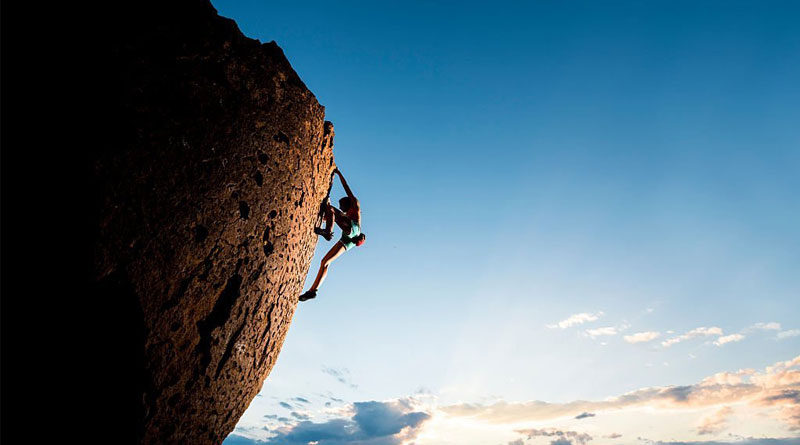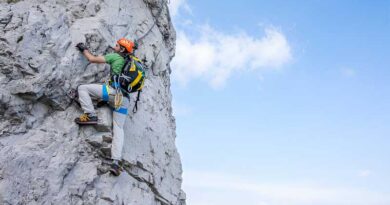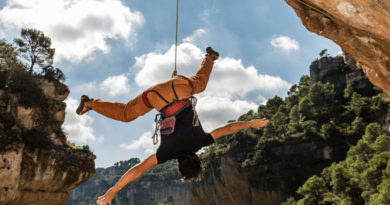Can you Rock Climb without a Rope?
Yes, you can go rock climbing without a rope. There are two types of rock climbing that don’t require a rope. These include bouldering and free soloing. In bouldering, you climb up shorter boulders or rock formations without the use of ropes. It typically involves climbs that are no more than 20 feet high and is typically done over crash pads to protect against falls. There are several gyms that offer bouldering. You can also do bouldering outdoors.
Free soloing, on the other hand, is relatively risky and dangerous. It is recommended to only experienced climbers. You rely solely on your own strength, balance, and skill to ascend the rock face. It is often known as the pinnacle of climbing. Free soloing is typically done on stable rock formations with good hand and footholds. Despite the risks, free soloing is still a popular form of climbing for experienced climbers.
Bouldering
In bouldering, you climb shorter rock formations or boulders without the use of ropes or harnesses. You typically use crash pads to cushion your falls. You also need a few pieces of gear to get started as compared to free soloing. For example, climbing shoes and chalk. Bouldering shoes are specially designed to get a good grip on rocks. You also need chalk to improve your grip on rock surfaces. As mentioned earlier, you also need crash pads.
Risks of Bouldering
Bouldering can cause the following risks:
Falling: Since you are not attached to any rope, you can fall and it can be dangerous. So, use crash pads to reduce the impact of falls.
Injury: A fall can lead to an injury to the ligaments around your joints. Your muscles can stretch too much and tear off. Your bones can also break partially or completely.
Overuse injuries: Bouldering strains hands, wrists, and forearms, leading to overuse injuries without breaks or proper technique.
However, you can make your bouldering experience safe and enjoyable by taking some precautions.
Free Soloing
Free soloing is also a type of rock climbing that doesn’t involve any ropes and harnesses. This is considered most dangerous form of rock climbing because a single fall can lead to injury and even death. Due to these factors, I won’t recommend free soloing to any beginner climber. It should be done only by an experienced climber. You should practice the route many times using ropes and protective gear before attempting the climb without them.
Risks of Free Soloing
Free soloing is an extremely dangerous form of climbing due to the absence of any protective gear or equipment. The risks involved are high and any mistake or slip can have serious consequences. Here are some of the potential dangers and risks involved in free soloing:
- Falling – Falling is the most significant risk. Without any protective gear or equipment, a fall can be fatal. Especially if the rock face is steep or rocky.
- Rockfall – Rockfall is another risk associated with free soloing. Loose rocks can become dislodged and fall from above, potentially injuring or killing the climber.
- Weather conditions – Weather conditions can have a significant impact on the safety of a free solo climb. Often, rain and wind make it more challenging.
- Physical exhaustion – Free soloing requires a high level of physical exertion. You may become exhausted during the climb. Once you are exhausted, you make mistakes like wrong judgment, which lead to loss of focus and it ultimately increases the risk of fall.
- Mental exhaustion – Free soloing also requires a high level of mental focus and concentration. You may become mentally exhausted during the climb, which can impair your judgment and decision-making abilities.
- Inexperience – Free soloing should only be attempted by experienced climbers who are physically and mentally prepared for the challenges and risks involved. Never go free soloing if you don’t have the required skills.
- Medical emergencies – Medical emergencies can also happen such as a heart attack or stroke. In this case, you won’t have access to immediate medical attention.
So, take proper precautions and stay safe.
How to Prepare for Climbing Without Ropes?
Here are some tips on how to prepare for free soloing:
Physical preparation
Focus on building endurance, flexibility, upper body, and core strength. Cardiovascular exercises such as running and swimming can help improve your endurance. You can also built some upper body strength by doing pull-ups and push-ups.
Mental Preparation
Use visualization techniques to mentally prepare for the ascent. Practice meditation, breathing exercises, and positive self-talk to strengthen your mental resilience.
Technical Skills
Before attempting a free solo climb, always have a thorough understanding of the climbing route and environment. Practice the climbing techniques such as edging, smearing, and crack climbing. Also, practice downclimbing, which is climbing back down the route without any protective equipment.
Safety Precautions
Despite the lack of protective gear or equipment, you can still take safety precautions to reduce the risks associated with free soloing. Make sure you always climb with a partner or support team who can help in an emergency.
Gradual Progression
Do not attempt a free solo climb unless you have gained enough experience and skill. Try to progress to more difficult climbs gradually beginning with routes that are well within your comfort zone and gradually increasing the difficulty level.
Safety Tips
Here are some tips for safe free soloing:
- Know your limits – Attempt only when you are physically and mentally prepared for the climb. Do not attempt routes that are beyond your skill level or comfort zone.
- Scout the route – Thoroughly scout the climbing route before attempting a free solo climb. Note any potential hazards or loose rocks and assess the difficulty level of the climb.
- Warm-up and stretch – Before attempting a free solo climb, warm up and stretch to prevent injury and improve your flexibility.
- Use chalk – Use chalk to improve grip and prevent hands from sweating.
- Climb during optimal conditions – Always attempt a free solo climb during optimal weather conditions when the rock is dry and the visibility is good. Never climb when it is pouring down.
- Use a spotter – A spotter can be a valuable safety precaution when free soloing. A spotter can watch you and provide assistance in case of a fall or other emergency.
- Keep a clear mind – Maintain a clear mind and stay focused during the climb. Do not allow distractions or other factors that can affect your concentration.
- Practice downclimbing – You should also practice downclimbing. It involves climbing back down the route without any protective gear. Downclimbing is an important skill for free soloing and can help you safely navigate a climb.
Remember, free soloing is an extreme and dangerous form of climbing. Take every precaution to ensure safety.
Conclusion
In conclusion, rock climbing without a rope is possible but it is not without risks and challenges. Bouldering is a popular form of climbing without a rope that can be practiced indoors or outdoors. On the other hand, free soloing is climbing without any protective gear. Free soloing is a dangerous forms of rock climbing and you should only attempt it if you are an experienced climber. While free soloing can be a thrilling and rewarding experience, the risk involved is extremely high. Free soloing can lead to serious injury or even death.




